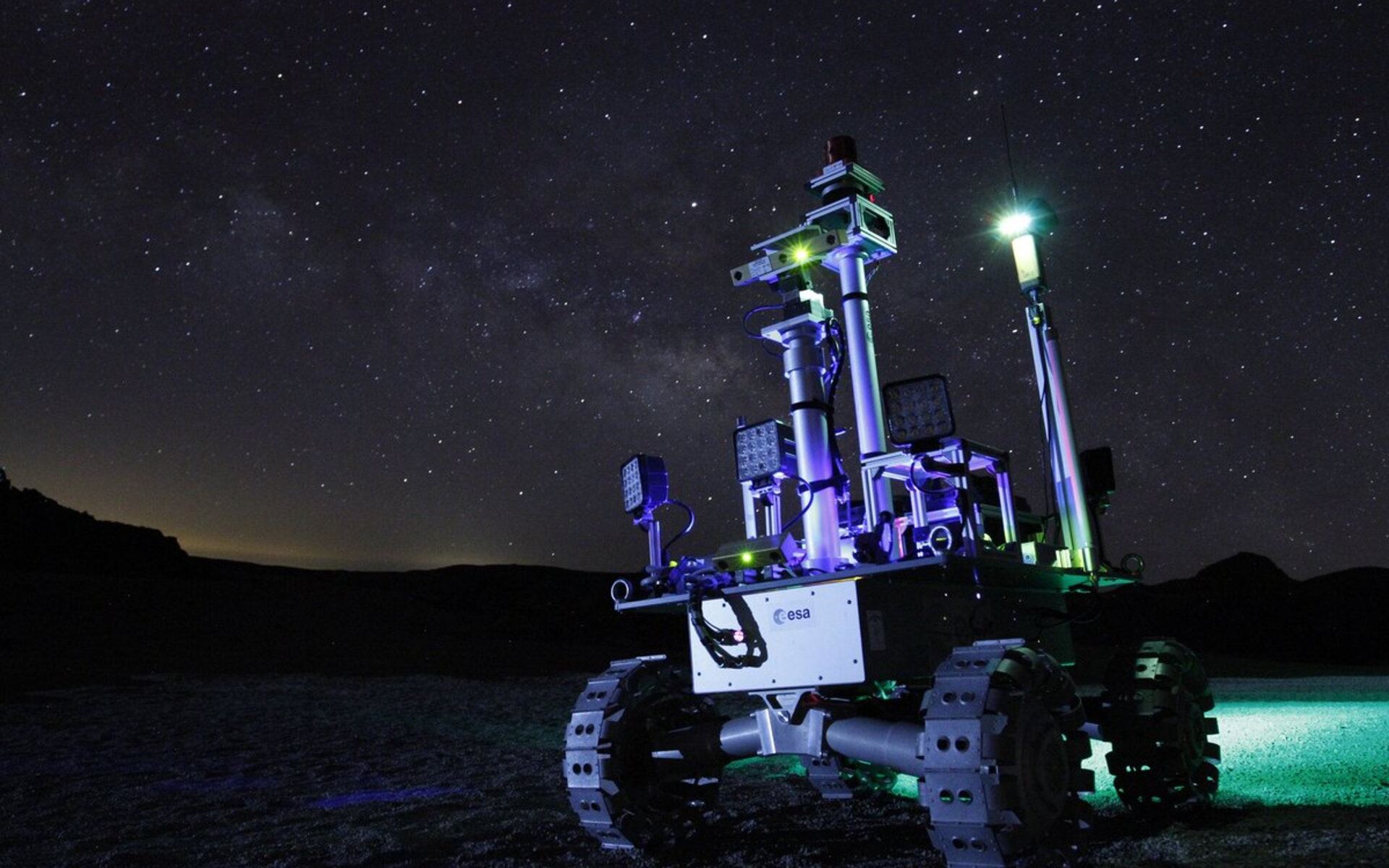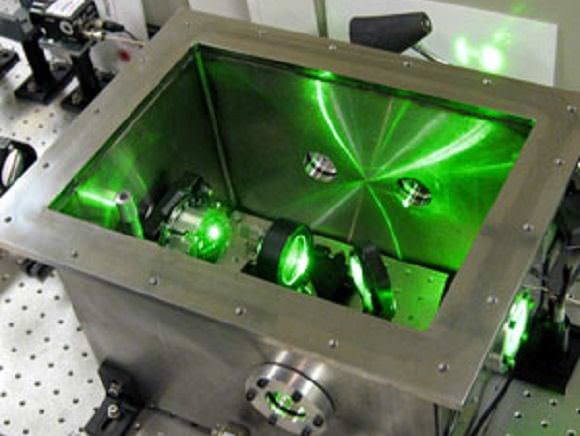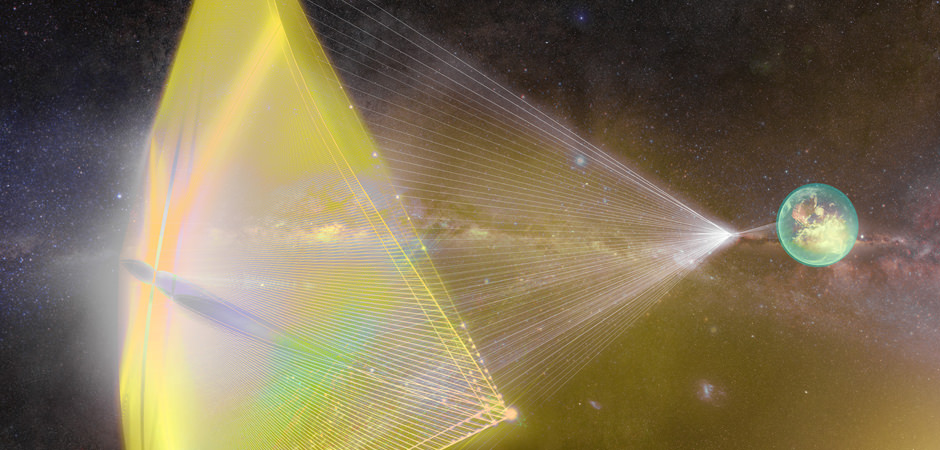The craters on the Moon’s poles are in permanent shadow. But they’re also intriguing locations, due to deposits of water ice and other materials. The ESA is developing the idea for a rover that can explore these areas with power provided by lasers.
Continue reading “This Laser Powered Rover Could Stay in the Shadows on the Moon and Continue to Explore”The Ant Nebula Actually has Intense Laser Emissions Coming From its Core
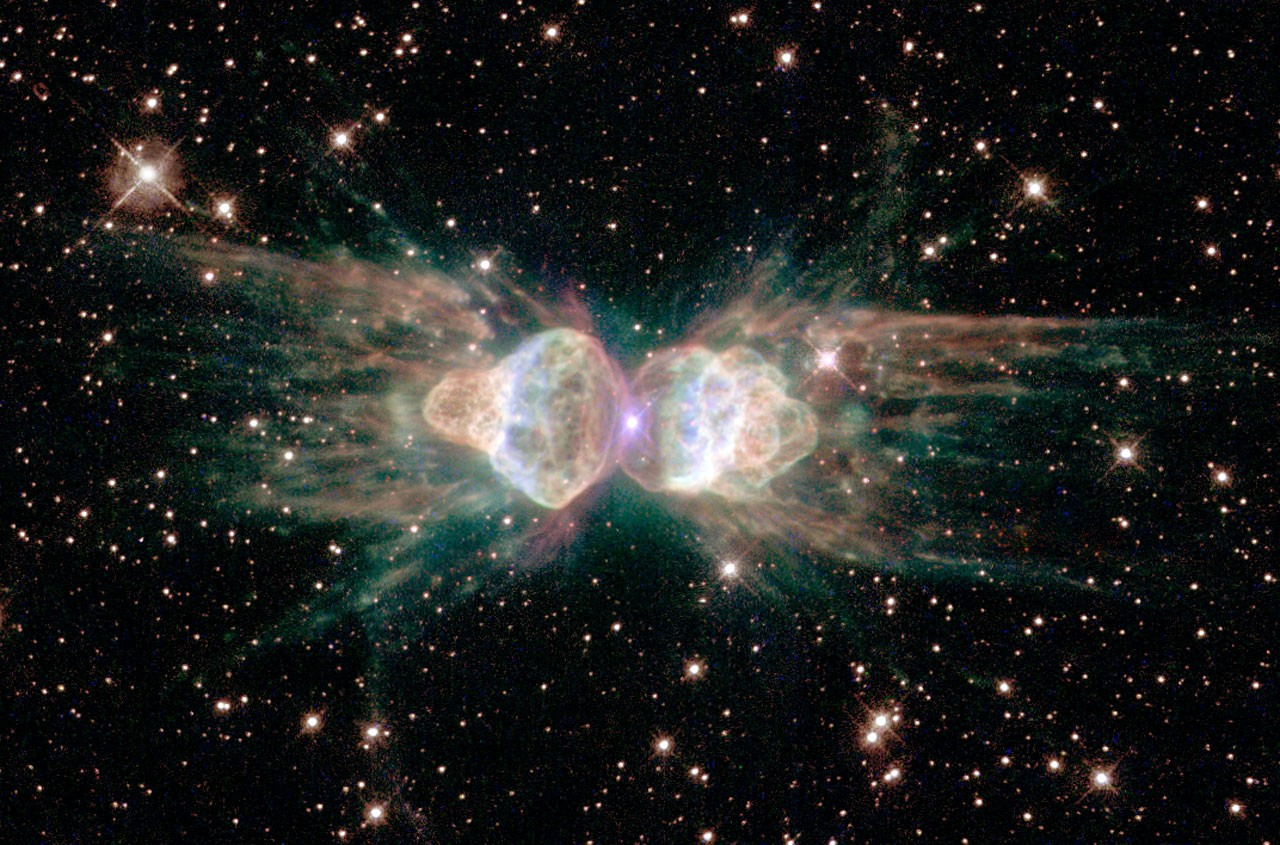
When low- to middleweight stars like our Sun approach the end of their life cycles they eventually cast off their outer layers, leaving behind a dense, white dwarf star. These outer layers became a massive cloud of dust and gas, which is characterized by bright colors and intricate patterns, known as a planetary nebula. Someday, our Sun will turn into such a nebula, one which could be viewed from light-years away.
This process, where a dying star gives rise to a massive cloud of dust, was already known to be incredibly beautiful and inspiring thanks to many images taken by Hubble. However, after viewing the famous Ant Nebula with the European Space Agency’s (ESA) Herschel Space Observatory, a team of astronomers discovered an unusual laser emission that suggests that there is a double star system at the center of the nebula.
The study, titled “Herschel Planetary Nebula Survey (HerPlaNS): hydrogen recombination laser lines in Mz 3“, recently appeared in the Monthly Notices of the Royal Astronomical Society. The study was led by Isabel Aleman of the the Institute of Astronomy and Astrophysics, the and multiple universities.
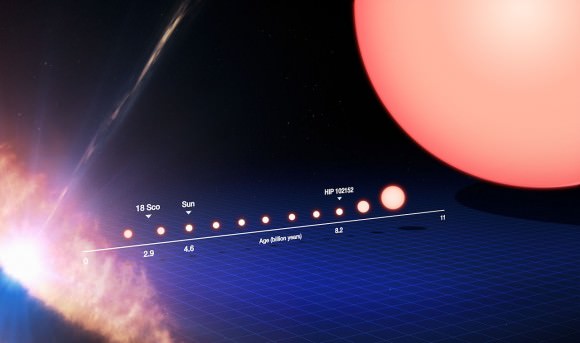
The Ant Nebula (aka. Mz 3) is a young bipolar planetary nebula located in the constellation Norma, and takes its name from the twin lobes of gas and dust that resemble the head and body of an ant. In the past, this nebula’s beautiful and intricate nature was imaged by the NASA/ESA Hubble Space Telescope. The new data obtained by Herschel also indicates that the Ant Nebula beams intense laser emissions from its core.
In space, infrared laser emissions are detected at very different wavelengths and only under certain conditions, and only a few of these space lasers are known. Interestingly enough, it was astronomer Donald Menzel – who first observed and classified the Ant Nebula in 1920 (hence why it is officially known as Menzel 3 after him) – who was one of the first to suggest that lasers could occur in nebula.
According to Menzel, under certain conditions natural “light amplification by the stimulated emissions of radiation” (aka. where we get the term laser from) would occur in space. This was long before the discovery of lasers in laboratories, an occasion that is celebrated annually on May 16th, known as UNESCO’s International Day of Light. As such, it was highly appropriate that this paper was also published on May 16th, celebrating the development of the laser and its discoverer, Theodore Maiman.
As Isabel Aleman, the lead author of a paper, described the results:
“When we observe Menzel 3, we see an amazingly intricate structure made up of ionized gas, but we cannot see the object in its center producing this pattern. Thanks to the sensitivity and wide wavelength range of the Herschel observatory, we detected a very rare type of emission called hydrogen recombination line laser emission, which provided a way to reveal the nebula’s structure and physical conditions.”
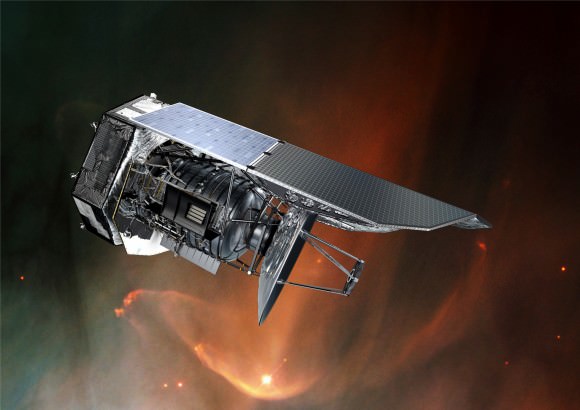
“Such emission has only been identified in a handful of objects before and it is a happy coincidence that we detected the kind of emission that Menzel suggested, in one of the planetary nebulae that he discovered,” she added.
The kind of laser emission they observed needs very dense gas close to the star. By comparing observations from the Herschel observatory to models of planetary nebula, the team found that the density of the gas emitting the lasers was about ten thousand times denser than the gas seen in typical planetary nebulae, and in the lobes of the Ant Nebula itself.
Normally, the region close to the dead star – in this case, roughly the distance between Saturn and the Sun – is quite empty because its material was ejected outwards after the star went supernova. Any lingering gas would soon fall back onto it. But as Professor Albert Zijlstra, from the Jodrell Bank Center for Astrophysics and a co-author on the study, put it:
“The only way to keep such dense gas close to the star is if it is orbiting around it in a disc. In this nebula, we have actually observed a dense disc in the very center that is seen approximately edge-on. This orientation helps to amplify the laser signal. The disc suggests there is a binary companion, because it is hard to get the ejected gas to go into orbit unless a companion star deflects it in the right direction. The laser gives us a unique way to probe the disc around the dying star, deep inside the planetary nebula.”
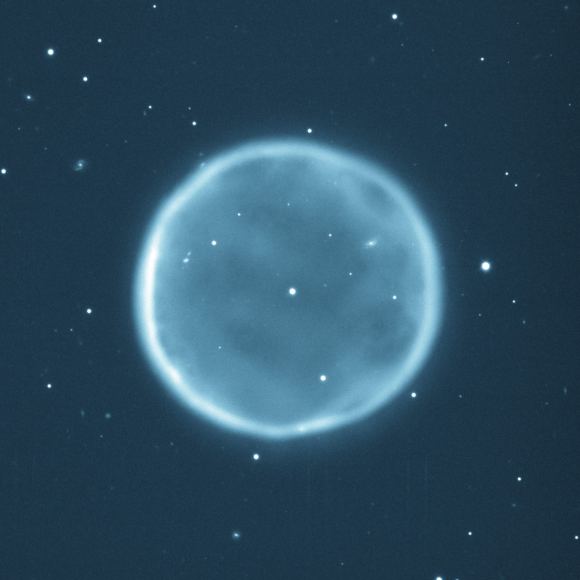
While astronomers have not yet seen the expected second star, they are hopeful that future surveys will be able to locate it, thus revealing the origin of the Ant Nebula’s mysterious lasers. In so doing, they will be able to connect two discoveries (i.e. planetary nebula and laser) made by the same astronomer over a century ago. As Göran Pilbratt, ESA’s Herschel project scientist, added:
“This study suggests that the distinctive Ant Nebula as we see it today was created by the complex nature of a binary star system, which influences the shape, chemical properties, and evolution in these final stages of a star’s life. Herschel offered the perfect observing capabilities to detect this extraordinary laser in the Ant Nebula. The findings will help constrain the conditions under which this phenomenon occurs, and help us to refine our models of stellar evolution. It is also a happy conclusion that the Herschel mission was able to connect together Menzel’s two discoveries from almost a century ago.”
Next-generation space telescopes that could tell us more about planetary nebula and the life-cycles of stars include the James Webb Space Telescope (JWST). Once this telescope takes to space in 2020, it will use its advanced infrared capabilities to see objects that are otherwise obscured by gas and dust. These studies could reveal much about the interior structures of nebulae, and perhaps shed light on why they periodically shoot out “space lasers”.
Further Reading: University of Manchester, ESA, MNRAS
China Has a Plan to Clean Up Space Junk with Lasers
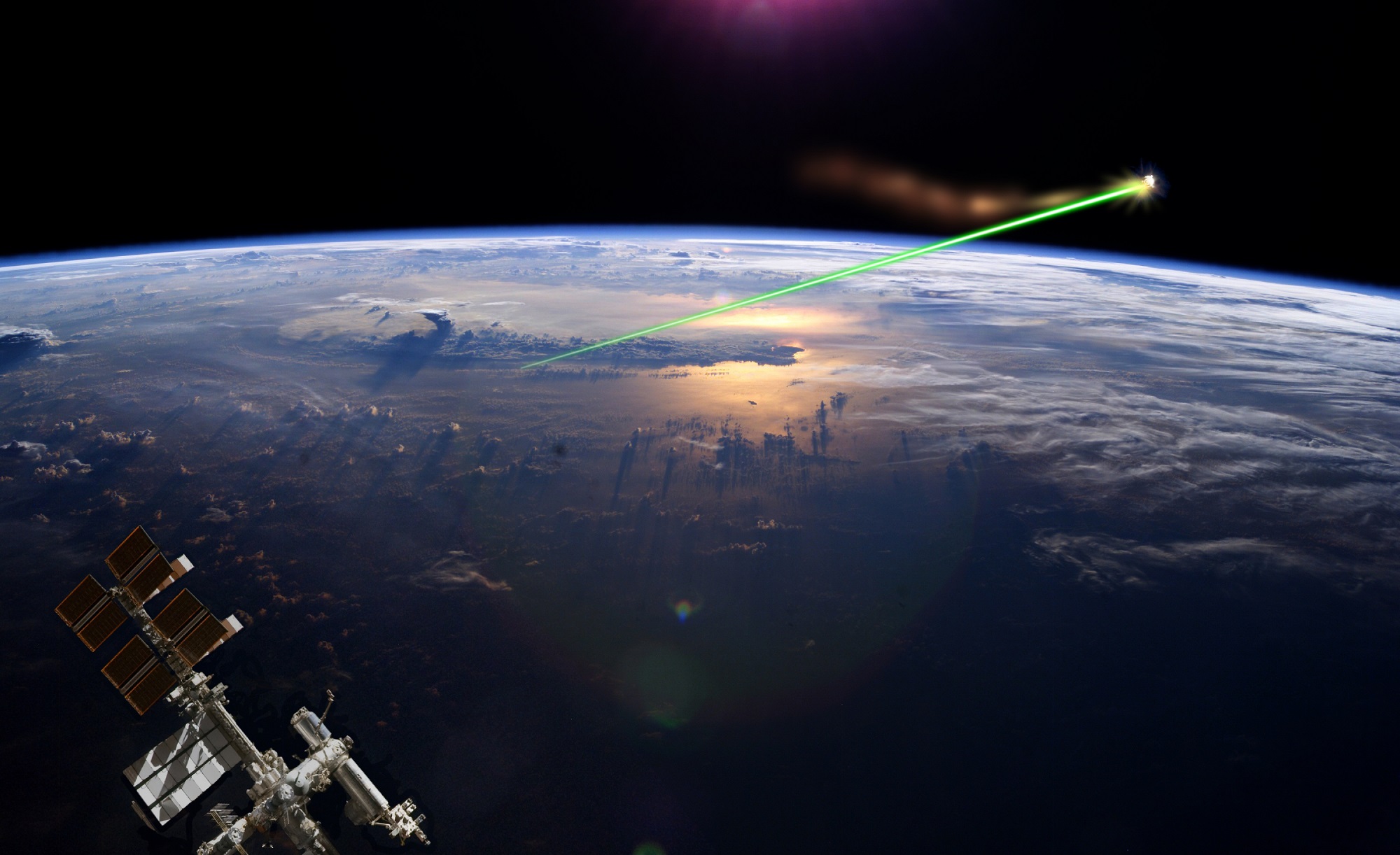
Orbital debris (aka. space junk) is one of the greatest problems facing space agencies today. After sixty years of sending rockets, boosters and satellites into space, the situation in the Low Earth Orbit (LEO) has become rather crowded. Given how fast debris in orbit can travel, even the tiniest bits of junk can pose a major threat to the International Space Station and threaten still-active satellites.
It’s little wonder then why ever major space agency on the planet is committed to monitoring orbital debris and creating countermeasures for it. So far, proposals have ranged from giant magnets and nets and harpoons to lasers. Given their growing presence in space, China is also considering developing giant space-based lasers as a possible means for combating junk in orbit.
One such proposal was made as part of a study titled “Impacts of orbital elements of space-based laser station on small scale space debris removal“, which recently appeared in the scientific journal Optik. The study was led by Quan Wen, a researcher from the Information and Navigation College at China’s Air Force Engineering University, with the help of the Institute of China Electronic Equipment System Engineering Company.

For the sake of their study, the team conducted numerical simulations to see if an orbital station with a high-powered pulsed laser could make a dent in orbital debris. Based on their assessments of the velocity and trajectories of space junk, they found that an orbiting laser that had the same Right Ascension of Ascending Node (RAAN) as the debris itself would be effective at removing it. As they state in their paper:
“The simulation results show that, debris removal is affected by inclination and RAAN, and laser station with the same inclination and RAAN as debris has the highest removal efficiency. It provides necessary theoretical basis for the deployment of space-based laser station and the further application of space debris removal by using space-based laser.”
This is not the first time that directed-energy has been considered as a possible means of removing space debris. However, the fact that China is investigating directed-energy for the sake of debris removal is an indication of the nation’s growing presence in space. It also seems appropriate since China is considered to be one of the worst offenders when to comes to producing space junk.
Back in 2007, China conducted a anti-satellite missile test that resulted in the creation over 3000 of bits of dangerous debris. This debris cloud was the largest ever tracked, and caused significant damage to a Russian satellite in 2013. Much of this debris will remain in orbit for decades, posing a significant threat to satellites, the ISS and other objects in LEO.
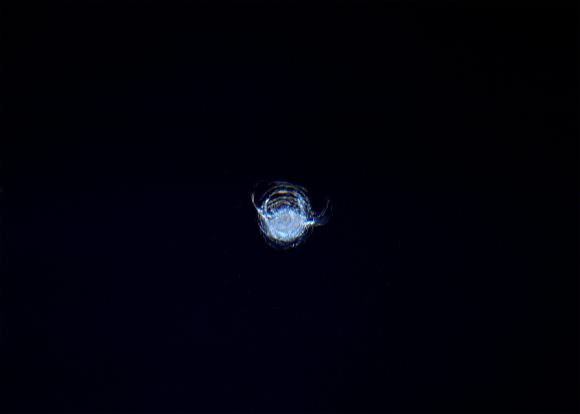
Of course, there are those who fear that the deployment of lasers to LEO will mean the militarization of space. In accordance with the 1966 Outer Space Treaty, which was designed to ensure that the space exploration did not become the latest front in the Cold War, all signatories agreed to “not place nuclear weapons or other weapons of mass destruction in orbit or on celestial bodies or station them in outer space in any other manner.”
In the 1980s, China was added to the treaty and is therefore bound to its provisions. But back in March of 2017, US General John Hyten indicated in an interview with CNN that China’s attempts to develop space-based laser arrays constitutes a possible breach of this treaty:
“They’ve been building weapons, testing weapons, building weapons to operate from the Earth in space, jamming weapons, laser weapons, and they have not kept it secret. They’re building those capabilities to challenge the United States of America, to challenge our allies…We cannot allow that to happen.”
Such concerns are quite common, and represent a bit of a stumbling block when it comes to the use of directed-energy platforms in space. While orbital lasers would be immune to atmospheric interference, thus making them much more effective at removing space debris, they would also lead to fears that these lasers could be turned towards enemy satellites or stations in the event of war.
As always, space is subject to the politics of Earth. At the same time, it also presents opportunities for cooperation and mutual assistance. And since space debris represents a common problem and threatens any and all plans for the exploration of space and the colonization of LEO, cooperative efforts to address it are not only desirable but necessary.
Team Creates Negative Effective Mass In The Lab

When it comes to objects and force, Isaac Newton’s Three Laws of Motion are pretty straightforward. Apply force to an object in a specific direction, and the object will move in that direction. And unless there’s something acting against it (like gravity or air pressure) it will keep moving in that direction until something stops it. But when it comes to “negative mass”, the exact opposite is true.
As the name would suggest, the term refers to matter whose mass is opposite that of normal matter. Until a few years ago, negative mass was predominantly a theoretical concept and had only been observed in very specific settings. But according to a recent study by an international team of researchers, they managed to create a fluid with a “negative effective mass” under laboratory conditions for the first time .
To put it in the simplest terms, matter can have a negative mass in the same way that a particle can have a negative charge. When it comes to the Universe that we know and study on a regular basis, one could say that we have encountered only the positive form of mass. In fact, one could say that it is the same situation with matter and antimatter. Theoretical physics tells us both exist, but we only see the one on a regular basis.
As Dr. Michael McNeil Forbes – a Professor at Washington State University, a Fellow at the Institute for Nuclear Theory, and a co-author on the study – explained in a WSU press release:
“That’s what most things that we’re used to do. With negative mass, if you push something, it accelerates toward you. Once you push, it accelerates backwards. It looks like the rubidium hits an invisible wall.”
According to the team’s study, which was recently published in the Physical Review Letters (under the title “Negative-Mass Hydrodynamics in a Spin-Orbit–Coupled Bose-Einstein Condensate“), a negative effective mass can be created by altering the spin-orbit coupling of atoms. Led by Peter Engels – a professor of physics and astronomy at Washington State University – this consisted of using lasers to control the behavior of rubidium atoms.
They began by using a single laser to keep rubidium atoms in a bowl measuring less than 100 microns across. This had the effect of slowing the atoms down and cooling them to just a few degrees above absolute zero, which resulted in the rubidium becoming a Bose-Einstein condensate. Named after Satyendra Nath Bose and Albert Einstein (who predicted how their atoms would behave) these types of condensates behaves like a superfluid.
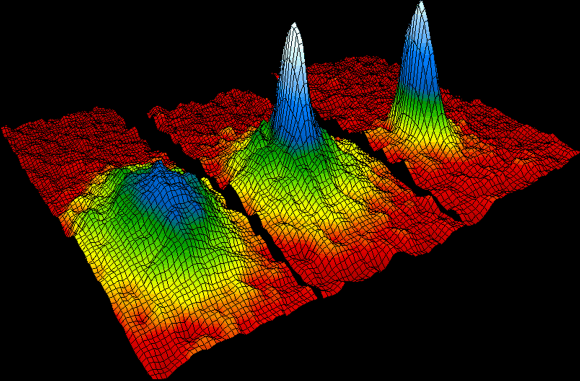
Basically, this means that their particles move very slowly and behave like waves, but without losing any energy. A second set of lasers was then applied to move the atoms back and forth, effectively changing the way they spin. Prior to the change in their spins, the superfluid had regular mass and breaking the bowl would result in them pushing out and expanding away from their center of mass.
But after the application of the second laser, the rubidium rushed out and accelerated in the opposite direction – consistent with how a negative mass would. This represented a break with previous laboratory experiments, where researchers were unable to get atoms to behave in a way that was consistent with negative mass. But as Forbes explained, the WSU experiment avoided some of the underlying defects encountered by these experiments:
“What’s a first here is the exquisite control we have over the nature of this negative mass, without any other complications. It provides another environment to study a fundamental phenomenon that is very peculiar.”
And while news of this experiment has been met with fanfare and claims to the effect that the researchers had “rewritten the laws of physics”, it is important to emphasize that this research has created a “negative effective mass” – which is fundamentally different from a negative mass.
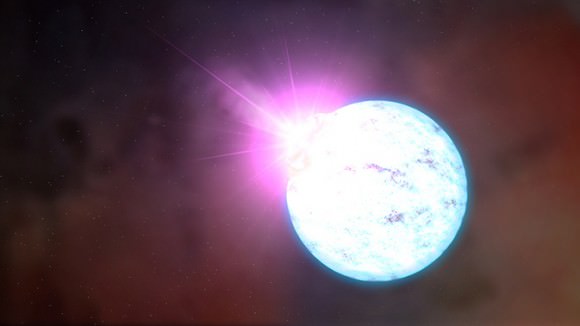
Credit: NASA/Goddard Space Flight Center
As Sabine Hossenfelder, a Research Fellow at the Frankfurt Institute for Advanced Studies, wrote on her website Backreaction in response to the news:
“Physicists use the preamble ‘effective’ to indicate something that is not fundamental but emergent, and the exact definition of such a term is often a matter of convention. The ‘effective radius’ of a galaxy, for example, is not its radius. The ‘effective nuclear charge’ is not the charge of the nucleus. And the ‘effective negative mass’ – you guessed it – is not a negative mass. The effective mass is merely a handy mathematical quantity to describe the condensate’s behavior.”
In other words, the researchers were able to get atoms to behave as a negative mass, rather than creating one. Nevertheless, their experiment demonstrates the level of control researchers now have when conducting quantum experiments, and also serves to clarify how negative mass behaves in other systems. Basically, physicists can use the results of these kinds of experiments to probe the mysteries of the Universe where experimentation is impossible.
These include what goes on inside neutron stars or what transpires beneath the veil of a event horizon. Perhaps they could even shed some light on questions relating to dark energy.
Further Reading: Physical Review Letters, WSU
How Can We Save The Sun?
Remember the movie Sunshine, where astronomers learn that the Sun is dying? So a plucky team of astronauts take a nuclear bomb to the Sun, and try to jump-start it with a massive explosion. Yeah, there’s so much wrong in that movie that I don’t know where to start. So I just won’t.
Seriously, a nuclear bomb to cure a dying Sun?
Here’s the thing, the Sun is actually dying. It’s just that it’s going to take about another 5 billion years to run of fuel in its core. And when it does, Cillian Murphy won’t be able to restart it with a big nuke.
But the Sun doesn’t have to die so soon. It’s made of the same hydrogen and helium as the much less massive red dwarf stars. And these stars are expected to last for hundreds of billions and even trillions of years.
Is there anything we can do to save the Sun, or jump-start it when it runs out of fuel in the core?
First, let me explain the problem. The Sun is a main sequence star, and it measures 1.4 million kilometers across. Like ogres and onions, the Sun is made of layers.
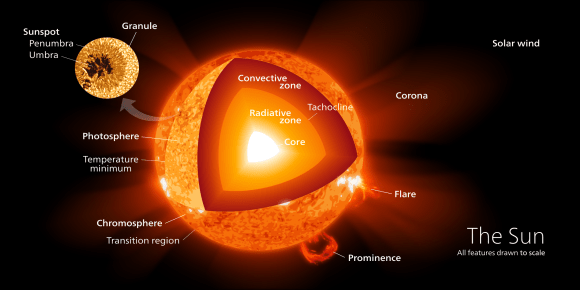
The innermost layer is the core. That’s the region where the temperature and pressure is so great that atoms of hydrogen are mashed together so tightly they can fuse into helium. This fusion reaction is exothermic, which means that it gives off more energy than it consumes.
The excess energy is released as gamma radiation, which then makes its way through the star and out into space. The radiation pushes outward, and counteracts the inward force of gravity pulling it together. This balance creates the Sun we know and love.
Outside the core, temperatures and pressures drop to the point that fusion can no longer happen. This next region is known as the radiative zone. It’s plenty hot, and the photons of gamma radiation generated in the core of the Sun need to bounce randomly from atom to atom, maybe for hundreds of thousands of years to finally escape. But it’s not hot enough for fusion to happen.
Outside the radiative zone is the convective zone. This is where the material in the Sun is finally cool enough that it can move around like a lava lamp. Hot blobs of plasma pick up enormous heat from the radiative zone, float up to the surface of the Sun, release their heat and then sink down again.
The only fuel the Sun can use for fusion is in the core, which accounts for only 0.8% of the Sun’s volume and 34% of its mass. When it uses up that hydrogen in the core, it’ll blow off its outer layers into space and then shrink down into a white dwarf.
The radiative zone acts like a wall, preventing the mixing convective zone from reaching the solar core.
If the Sun was all convective zone, then this wouldn’t be a problem, it would be able to go on mixing its fuel, using up all its hydrogen instead of this smaller fraction. If the Sun was more like a red dwarf, it could last much longer.
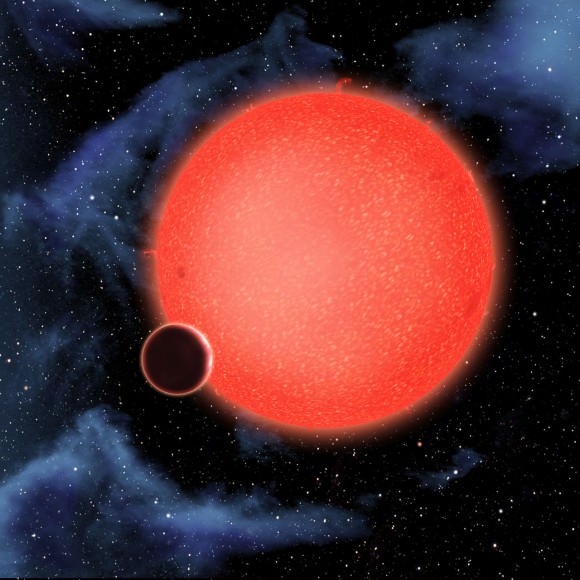
In order to save the Sun, to help it last longer than the 5 billion years it has remaining, we would need some way to stir up the Sun with a gigantic mixing spoon. To get that unburned hydrogen from the radiative and convective zones down into the core.
One idea is that you could crash another star into the Sun. This would deliver fresh fuel, and mix up the Sun’s hydrogen a bit. But it would be a one time thing. You’d need to deliver a steady stream of stars to keep mixing it up. And after a while you would accumulate enough mass to create a supernova. That would be bad.
But another option would be to strip material off the Sun and create red dwarfs. Stars with less than 35% the mass of the Sun are fully convective. Which means that they don’t have a radiative zone. They fully mix all their hydrogen fuel into the core, and can last much longer.
Imagine a future civilization tearing the Sun into 3 separate stars, each of which could then last for hundreds of billions of years, putting out only 1.5% the energy of the Sun. Huddle up for warmth.
But if you want to take this to the extreme, tear the Sun into 13 separate red dwarf stars with only 7.5% the mass of the Sun. These will only put out .015% the light of the Sun, but they’ll sip away at their hydrogen for more than 10 trillion years.
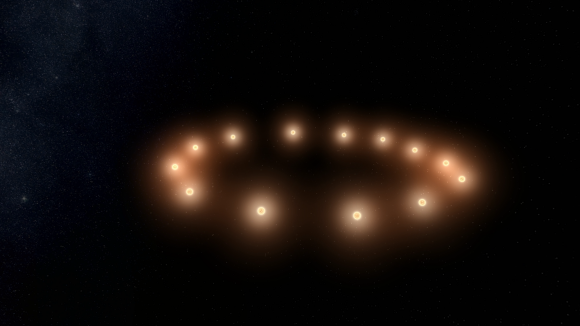
But how can you get that hydrogen off the Sun? Lasers, of course. Using a concept known as stellar lifting, you could direct a powerful solar powered laser at a spot on the Sun’s surface. This would heat up the region, and generate a powerful solar wind. The Sun would be blasting its own material into space. Then you could use magnetic fields or gravity to direct the outflows and collect them into other stars. It boggles our imagination, but it would be a routine task for Type III Civilization engineers on star dismantling duty.
So don’t panic that our Sun only has a few billion years of life left. We’ve got options. Mind bendingly complicated, solar system dismantling options. But still… options.
Don’t Want Aliens Dropping By? Engage Laser Cloaking Device
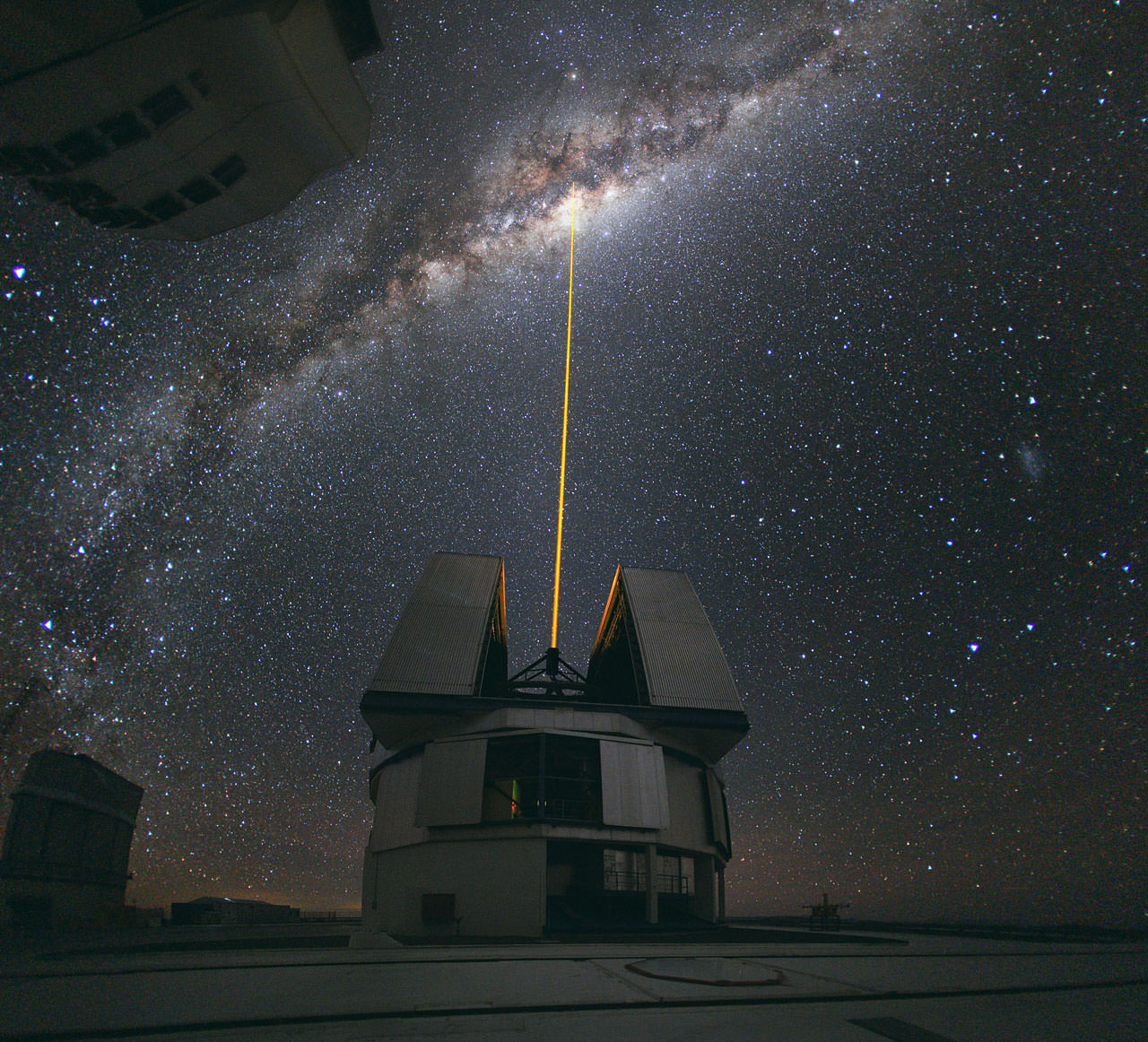
Of course we all know that aliens want to take over Earth. It’s in all the movies. And after they take over, they could do whatever they want to us puny, weak Earthlings. Enslavement? Yup. Forced breeding programs? Sure. Lay eggs in our bellies and consume our guts for their first meal? Why not.
But here at Universe Today, we’re science-minded types. We love the science fiction, but don’t take it too seriously. But someone we do take seriously when he has something to tell us is Stephen Hawking. And when he warned us that aliens might want to conquer and colonize us, it lent gravity to the whole discussion around contact with aliens. Should we reach out to alien civilizations? Will we be safe if they find us? Or should we try to conceal our presence?
If we choose concealment, then a new paper from two astronomers at New York’s Columbia University have good news for humanity. The authors of the paper, Professor David Kipping and graduate student Alex Teachey, say that lasers could be used to hide Earth from alien prying eyes.
At the heart of this whole idea are transits. When a planet passes in between its star and a distant observer, the star’s light is dimmed, and that’s called a transit. This is how the Kepler spacecraft detects exo-planets, and it’s been remarkably successful. If alien species are using the same method, which makes sense, then Earth would be easily detectable in the Sun’s habitable zone.
According to Kipping and Teachey, lasers could be used to mask this effect. A 30 MW laser would be enough to counter the dimming effect of Earth’s transit in front of the Sun. And it would only need to be turned on for 10 hours, once every year, since that’s how long Earth’s transit takes.
But that would only take care of the dimming effect in visible light. To counter-act the transit dimming across the whole electromagnetic spectrum would require much more energy: a 250 MW cloak of lasers tuned all across the spectrum. But there might be a middle way.
According to an interview with the paper’s authors in Science Daily, it might take only 160 MW of lasers to mask biological signatures in the atmosphere. Any prying alien eyes would not notice that life had ever come into being on Earth.
Should we decide that we do indeed want to be colonized, or forced to take part in breeding programs, or be enslaved, then the same system of lasers could be used to amplify the transit effect. This would make it easier, rather than harder, for aliens to detect us. In fact, according to the authors, these lasers could even be used to communicate with aliens, by transmitting information.
Of course, there’s one other element to all this. For this to work, we have to know where to aim the lasers, which means we have to know where the alien civilization is. And if we’re worried about them coming to get us, they will have more advanced technology than us. And if they have more advanced technology than us, they will for sure already have laser cloaking like the type talked about here.
So who’ll be the first to blink, and turn off their laser cloaking and allow detection?
You first, aliens.
Do We Really Need Rockets to Go to Space?
We’re familiar with rockets, those controlled explosions that carry cargo and fragile humans to space. But are there some non-rocket ways we could get to space?
Want to go space? Get a rocket. Nothing else ever invented can release the tremendous amounts of energy in a controlled way to get you to orbit.
It all comes down to velocity. Right now, you’re standing still on the Earth. If you jump up, you’ll come right back down where you started. But if you had a sideways velocity of 10 meters/second and you jumped up, you’d land downrange a few meters… painfully. And if you were moving 7,800 meters per second sideways – and you were a few hundred kilometers up – you’d just orbit the Earth.
Gaining that kind of velocity takes rockets. These magical science thundertubes are incredibly expensive, inefficient and single-use. Imagine if you had to buy a new car for each commute. Just blasting a single kilogram to orbit typically costs about $10,000. When you buy a trip to space, only a few hundred k goes to the gas. Those millions of dollars mostly go into the cost of the rocket that you’re going to kick to the curb once you’re done with it.
SpaceX is one of the most innovative rocket companies out there. They’re figuring ways to reuse as much of the rocket as they can, slashing those pesky launch costs, which ruin what should otherwise be a routine trip to the Moon. Maybe in the future, rockets could be used hundreds or even thousands of times, like your car, or commercial airliners.
Is that the best we could do? Can’t we just ditch the rockets altogether? To get from the ground to orbit, you need to gain 7,800 meters per second of velocity. A rocket gives you that velocity through constant acceleration, but could you deliver that kind of velocity in a single kick?
How about a huge gun and just shoot things into orbit? You need to instantly impart enormous velocity to the vehicle. This creates thousands of times the force of gravity on the passengers. Anyone on board gets turned into a fine red coating distributed evenly throughout the cabin interior. You can only get away with this a few times before your guinea pig passengers get wise.
“Steward, there’s bone chips in my champagne!”
If you extend the length of the barrel of the gun over many kilometers, you can smooth out the force of acceleration that humans can actually withstand. This is the idea Startram proposed. They’re looking to build a track up the side of a mountain, and use electromagnetism to push a sled up to orbital velocity.
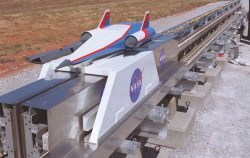
This might sound far fetched, but many countries are using with maglev technology with trains and breaking speed records around the world. The Japanese recently pushed a maglev train to 603 kilometers per hour. This first version of Startram would cost $20 billion, and the tremendous forces would only work for any cargo being delivered in a non-living state, despite how it started out.
Even more expensive is the version with a 1500-kilometer track, able to spread the acceleration over a longer period and allow humans to fly into space, arriving safely in their original “non-paste” configuration.
There are a couple teeny technical hurdles. Such as a track 20 kilometers in altitude where projectiles exit the muzzle and venting atmosphere to prevent the shockwave that would tear the whole structure apart.
If it can be made to work, we could decrease launch costs down to $50/kilogram. Meaning a trip to the International Space Station could cost $5,000.
Another idea would be, unsurprisingly, lasers. I know it sounds like I’m making this up. Lasers can fix every future problem. They could track and blast launch vehicles with a special coating that vaporizes into gas when it’s heated. This would generate thrust like a rocket, but the vehicle would have to carry a fraction of the mass of traditional fuel.
You don’t even need to hit the rocket itself to create thrust. A laser could superheat air right behind the launch vehicle to create a tiny shockwave and generate thrust. This technology has been demonstrated with the Lightcraft prototype.

What about balloons? It’s possible to launch balloons now that could get to such a high altitude that they’re above 90% of the Earth’s atmosphere. This significantly reduces the amount of atmospheric drag that rockets would need to complete the journey to space.
The space colonization pioneer Gerard K. O’Neill envisioned a balloon-based spaceport floating at the edge of space. Astronauts would depart from the spaceport, and require less thrust to reach orbit.
We’ve also talked about the idea of a space elevator. Stretching a cable from the Earth up to geostationary orbit, and carry payloads up that way. There are enormous hurdles to developing technology like that. There might not even be materials strong enough in the Universe to support the forces.
But a complete space elevator might not be necessary. It could be possible to use tethers rotating at the edge of space, which transfer momentum to spacecraft, raising them step by step to a higher velocity and eventually into orbit. These tethers lose velocity with each assist, but they could have some other propulsion system, like an ion drive, to restore their orbital velocity.
Future methods of accessing space will be a combination of some or all of these ideas together with traditional and reusable rockets. Balloons and air launch systems to decrease the rocket’s drag, electromagnetic acceleration to reduce the amount of fuel needed, and ground-based lasers to provide power and additional thrust and pew-pew noises. Perhaps with a series of tethers carrying payloads into higher and higher orbits.
It’s nice to know that engineers are working on new and better ways to access space. Rockets have made space exploration possible, but there are a range of technologies we can use to bring down the launch costs and open up whole new vistas of space exploration and colonization. I can’t wait to see what happens next.
What alternative methods of getting to space are you most excited about? Let us know your thoughts in the comments below.
The Challenges of Lasers in Space

Since the beginning of the space age, radio waves have been used for communication with spacecraft. But last month, NASA’s Lunar Laser Communication Demonstration (LLCD) made history by using a pulsed laser beam to transmit data over the 385,000 km (239,000 miles) between the Moon and Earth at a record-breaking download rate of 622 megabits per second (Mbps). This was NASA’s first system for two-way communication using a laser instead of radio waves. In our previous article today, we described how NASA will test out the Optical PAyload for Lasercomm Science (OPALS) on the International Space Station to demonstrate how videos can be beamed to Earth via laser beam.
What are the challenges in testing out an entirely new way of doing communications and other systems like navigation using lasers in space?
Don Cornwell, LLCD manager, discusses the challenges and successes they’ve had so far in this new video:
“The big change is the ability to do it by light, because the data rates that we’ve now done are just the opening shot, so to speak,” Cornwell said. “Radio communications systems have served us very well for the past 50 years but they are starting to run out of bandwidth, so in other words because of the frequency they use you can only modulate a certain portion of that frequencies and unless you move to higher frequencies – and light is a higher frequency than radio waves– you can’t squeeze a lot more bandwidth out, but the light systems in space, … we’ve now opened up a whole new field where we’re getting started , but the sky’s the limit regarding how much we can do there.”
Using lasers will allow for increased bandwidth for image resolution and 3-D video transmission from deep space, as well as allowing for tele-operation for long distances, such as from the Earth to the Moon.
LLCD is a short-duration experiment and the precursor to NASA’s long-duration demonstration, the Laser Communications Relay Demonstration (LCRD). LCRD is a part of the agency’s Technology Demonstration Missions Program, which is working to develop crosscutting technology capable of operating in the rigors of space. It is scheduled to launch in 2017.
Meanwhile, NASA has three other laser technology demonstration missions in the offing, likely launching in 2015 and 2016. One is a solar sail demonstration will enable propellantless laser in-space navigation for missions such as advanced geostorm warning, economic orbital debris removal, and deep space exploration.
Pew! Pew! Laser On The Space Station Will Beam Video To Earth

Videos will beam to Earth on a laser beam in a technology demonstration coming to the International Space Station soon, says NASA’s Jet Propulsion Laboratory.
The Optical PAyload for Lasercomm Science (OPALS) plans to move videos from space to an Optical Communications Telescope Laboratory in Wrightwood, Calif. Each demonstration test will last about 100 seconds, while the station and the ground receiver can “see” each other.
While the experiment sounds awesome for sending back “home videos” from space, NASA is more touting it as a boon for transferring loads of scientific data back to Earth.
“The scientific instruments in near-Earth and deep-space missions increasingly require higher communication rates to transmit their gathered data back to Earth or to support high-data-rate applications (e.g., high-definition video streams),” stated the OPALS webpage at NASA’s Jet Propulsion Laboratory.
“Optical communications (also referred to as ‘lasercomm’) is an emerging technology wherein data is modulated onto laser beams, which offers the promise of much higher data rates than what is achievable with radio-frequency (RF) transmissions.”
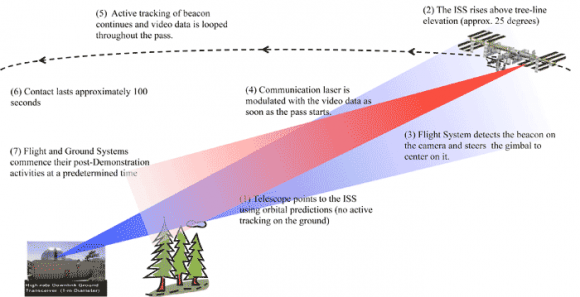
The experiment page (last updated in May) says it is intended to work for about a year, with the current Expedition 37/38 and forthcoming 39/40 crews. That said, it appears the payload is not aboard station yet.
A July update from NASA said the SpaceX Dragon spacecraft is supposed to ferry OPALS to space. There hasn’t been a Dragon flight since that time, but SpaceX is listing one more for 2013 on its launch manifest.
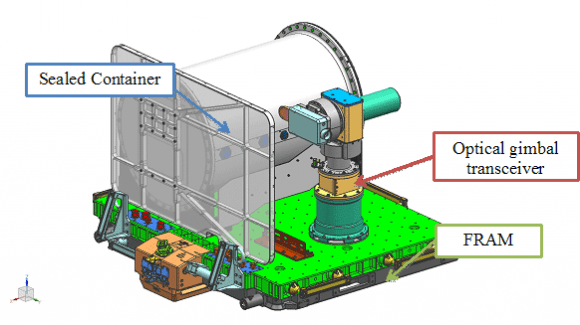
Laser communication hit headlines earlier this fall when the NASA Lunar Atmosphere and Dust Environment Explorer (LADEE) sent a packet of information by laser from the moon, breaking records in terms of download rate (622 megabits per second).

